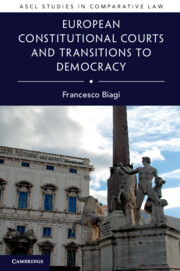Book contents
- European Constitutional Courts and Transitions to Democracy
- ASCL Studies in Comparative Law
- European Constitutional Courts and Transitions to Democracy
- Copyright page
- Dedication
- Contents
- Foreword
- Acknowledgments
- Notes on the Text
- Introduction
- 1 Democratic Transitions and Constitutional Courts
- 2 The First Generation
- 3 The Second Generation
- 4 The Third Generation
- 5 Comparing Three Generations
- Bibliography
- Index
5 - Comparing Three Generations
Published online by Cambridge University Press: 05 December 2019
- European Constitutional Courts and Transitions to Democracy
- ASCL Studies in Comparative Law
- European Constitutional Courts and Transitions to Democracy
- Copyright page
- Dedication
- Contents
- Foreword
- Acknowledgments
- Notes on the Text
- Introduction
- 1 Democratic Transitions and Constitutional Courts
- 2 The First Generation
- 3 The Second Generation
- 4 The Third Generation
- 5 Comparing Three Generations
- Bibliography
- Index
Summary
Chapter 5 brings things together with an analysis of the key lessons drawn from the discussion in the preceding chapters. In particular, it makes a comparison among the three generations of constitutional courts by topic, rather than country by country. This last chapter carries out an analysis of the various types of intervention of the constitutional judges, the reasons for the success of the centralized system of constitutional review, as well as the various factors influencing the activity of the courts. The analysis of the three generations shows that thanks to the actions carried out during the transition processes, the constitutional courts have managed to achieve full legitimation in their respective constitutional systems and within the dynamics of their respective forms of government. Although their action was not immune to criticism, the constitutional courts emerged as key players of the substantive transitions, reducing the high degree of uncertainty that characterizes the outcome of every transition process, and heading off the risk of ending up in a situation of constitutions without constitutionalism.
Keywords
- Type
- Chapter
- Information
- European Constitutional Courts and Transitions to Democracy , pp. 178 - 206Publisher: Cambridge University PressPrint publication year: 2020

